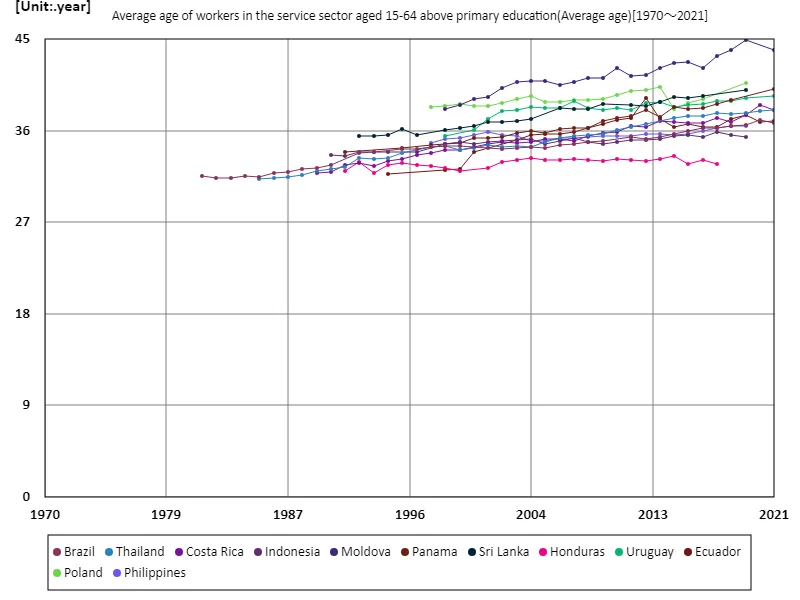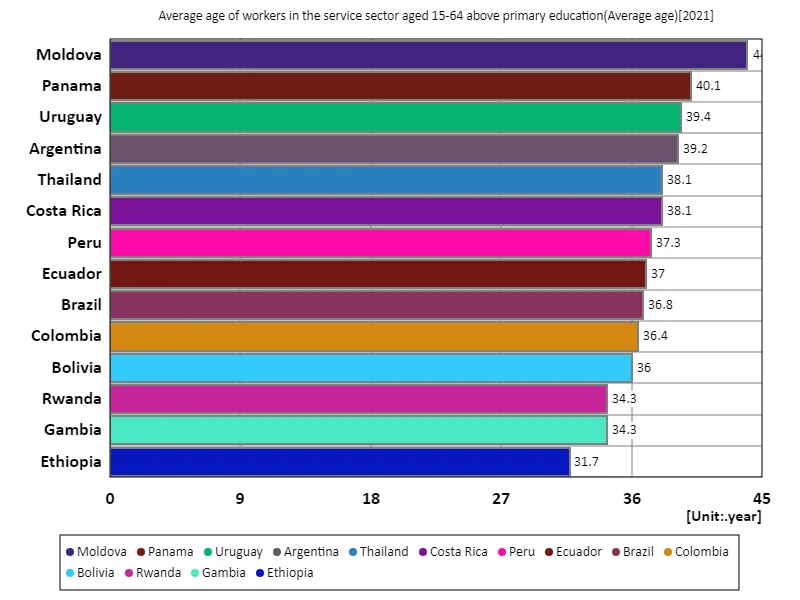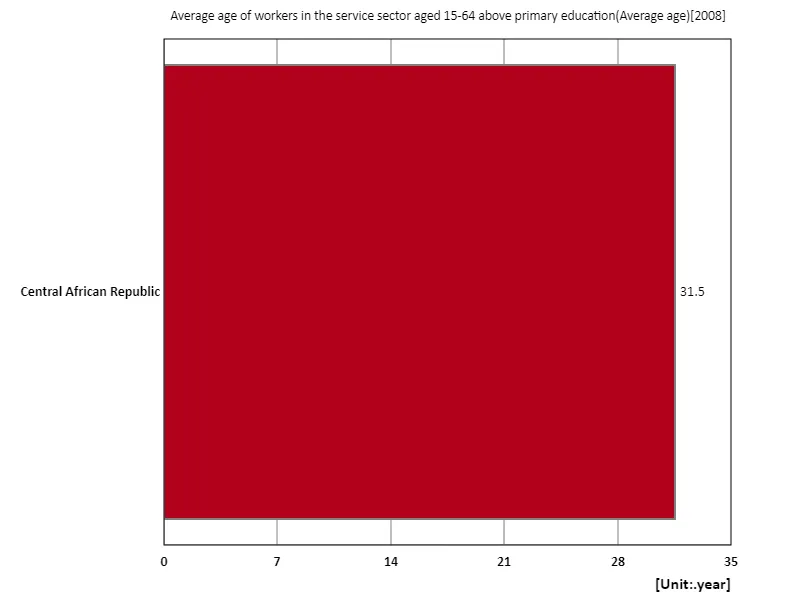- Abstract
- Service sector, workers aged 15-64 with secondary education or higher, average age
- Services sector, workers aged 15-64 with secondary education or higher, average age (worldwide)
- Services sector, workers aged 15-64 with secondary education or higher, average age (world countries, latest year)
- Services sector, workers aged 15-64 with secondary education or higher, average age (region, latest year)
- Reference
Abstract
There have been notable trends in the age composition of service sector workers in the global economy in recent years. The average age of workers with secondary education or higher qualifications between 15 and 64 years old varies widely across countries. In particular, Moldova’s 2021 data shows that the average age is high at 44 years old. This suggests that the labour market is ageing. This ageing is caused by several factors. First, as the labor force declines, there is a growing tendency for experienced workers to continue working for longer periods of time. Additionally, workers with secondary education or higher qualifications tend to be more specialised, meaning that experienced personnel are more highly valued. This has resulted in a trend towards an increasing average age for service sector workers. Furthermore, in countries like Moldova, slow economic development and structural challenges in the labour market may also be contributing factors. The combination of these factors creates a labor market dominated by older workers. This aging of the population could affect labor market flexibility and productivity in the future, so countries are calling for measures to secure young labor forces and improve labor markets.
Service sector, workers aged 15-64 with secondary education or higher, average age
Between 1981 and 2021, the average age of workers in the service sector with secondary education or higher, aged 15-64, has shown a notable change. In particular, Moldova recorded a peak of 44.9 years old in 2019 and is currently at 97.9% of that peak. The data reflect the ongoing ageing of the labour market in Moldova and the associated social and economic changes. This ageing trend has been reinforced by a decline in the labour force and an increasing desire among older people to continue working. As the number of workers with secondary education or higher qualifications increases, there is a trend for experienced workers to work longer. Additionally, economic reasons and the social security system can make it difficult for people to retire early. In the Moldova case, the ageing of the labour market is particularly evident, which may affect the social security system and the flexibility of the labour market. In the long term, it is important to secure a youthful workforce and balance the labour market. To address this trend, countries need to take measures such as reviewing labor market policies and reskilling workers.


The maximum is 44.9year[2019] of Moldova, and the current value is about 97.9%
Services sector, workers aged 15-64 with secondary education or higher, average age (worldwide)
Between 1981 and 2021, the average age of workers aged 15-64 with secondary education or higher in the service sector has risen steadily across countries. Italy in particular recorded a high average age of 45.8 years in 2014, but is now at 97% of that peak. This ageing trend is due to several important economic and social factors. The high average age of workers in Italy’s service sector is due to structural changes in the labour market. As people live longer, older people participate more in the labor market, and retirement ages rise, more experienced workers are likely to stay in the workforce longer. In addition, there is a shortage of young labor force, which is accelerating the aging of the population. This ageing population will have a variety of effects on businesses and the economy. In particular, a large older workforce can slow technological innovation and skill renewal. In addition, labor markets may become less flexible, making it more difficult to improve productivity. To address this issue, we need to promote employment for young people, improve retraining programs, and reform the labor market. Many countries, including Italy, are facing this challenge and are calling for the creation of sustainable labour markets.


The maximum is 45.8year[2014] of Italy, and the current value is about 97%
Services sector, workers aged 15-64 with secondary education or higher, average age (world countries, latest year)
According to 2021 data, the average age of workers aged 15-64 with secondary education or higher in the services sector is 37.3 years, with Moldova having the highest average age at 44 years. This reflects the ageing of the labour market and its effects. This trend is due to several important factors. First, people are living longer and older people are working longer, which means retirement ages are often being raised. This makes it common for older, more experienced workers to continue working for longer periods of time. Another factor is the declining birthrate and economic fluctuations that are affecting the labour supply of younger people, leaving older people in the labour market. In countries with a particularly high average age, such as Moldova, structural challenges in the labour market are evident. This is due to a shrinking labor force and slow economic development, with older workers becoming the majority of the workforce. If this ageing trend continues, it could affect companies’ competitiveness and productivity. In particular, there is a risk that technological innovation and skills renewal may slow down, which could become a constraint on economic growth. To address these challenges, policies are needed to develop the youth workforce and balance the labor market. We also need stronger policies to increase labour market flexibility and reskilling programmes.


The maximum is 44year of Moldova, the average is 37.3year, and the total is 523year
Services sector, workers aged 15-64 with secondary education or higher, average age (region, latest year)
In 2008 data, the average age of workers in the service sector aged 15-64 with secondary education or higher was 31.5 years, with the Central African Republic showing this average age. It is a key indicator of global labour market characteristics and trends. The Central African Republic’s median age of 31.5 reflects a relatively young workforce. African countries generally have a young-age skewed population, due to high birth rates and relatively short life expectancies. These countries tend to have a high proportion of young people in the labour market and therefore a relatively low average age. On the other hand, the global average is 31.5 years old, indicating a relatively young workforce even on a global scale. The figures highlight the differences in labour markets between developing and developed countries. Developed countries are experiencing an ageing population and the average age of service sector workers tends to be older, while developing countries have younger populations and the average age tends to be younger. Such age structures in the labour market have different impacts on the growth potential of the economy and the social security system. Countries with a youthful population are prone to rapid changes in labor market dynamics and provide dynamism for economic growth, while ageing countries require labor market stability and long-term strategies.


The maximum is 31.5year of Central African Republic, the average is 31.5year, and the total is 31.5year



Comments